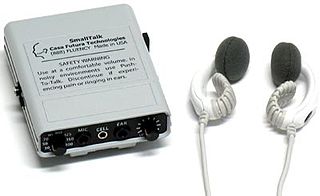
Assistive technology (AT) is assistive, adaptive, and rehabilitative devices for people with disabilities or the elderly population. People who have disabilities often have difficulty performing activities of daily living (ADLs) independently, or even with assistance. ADLs are self-care activities that include toileting, mobility (ambulation), eating, bathing, dressing, grooming, and personal device care. Assistive technology can ameliorate the effects of disabilities that limit the ability to perform ADLs. Assistive technology promotes greater independence by enabling people to perform tasks they were formerly unable to accomplish, or had great difficulty accomplishing, by providing enhancements to, or changing methods of interacting with, the technology needed to accomplish such tasks. For example, wheelchairs provide independent mobility for those who cannot walk, while assistive eating devices can enable people who cannot feed themselves to do so. Due to assistive technology, people with disabilities have an opportunity of a more positive and easygoing lifestyle, with an increase in "social participation," "security and control," and a greater chance to "reduce institutional costs without significantly increasing household expenses."

Parental controls are features which may be included in digital television services, computer and video games, mobile devices and software that allow parents to restrict the access of content to their children. These controls were created to assist parents in their ability to restrict certain content viewable by their children. This may be content they deem inappropriate for their age, maturity level or feel is aimed more at an adult audience. Parental controls fall into roughly four categories: content filters, which limit access to age inappropriate content; usage controls, which constrain the usage of these devices such as placing time-limits on usage or forbidding certain types of usage; computer usage management tools, which enforces the use of certain software; and monitoring, which can track location and activity when using the devices.

Interactive media normally refers to products and services on digital computer-based systems which respond to the user's actions by presenting content such as text, moving image, animation, video, audio, and video games.
Computer vision syndrome (CVS) is a condition resulting from focusing the eyes on a computer or other display device for protracted, uninterrupted periods of time and the eye muscles being unable to recover from the strain due to a lack of adequate sleep. Some symptoms of CVS include headaches, blurred vision, neck pain, fatigue, eye strain, dry eyes, irritated eyes, double vision, vertigo/dizziness, polyopia, and difficulty refocusing the eyes. These symptoms can be further aggravated by improper lighting conditions or air moving past the eyes.

Video game addiction also known as gaming disorder or internet gaming disorder is generally defined as problematic, compulsive use of video and/or internet games, that results in significant impairment in an individual's function in various life domains over a prolonged period of time. This and associated concepts have been under considerable research, debate and discussion among experts in several disciplines, and have generated controversy from the medical, scientific and gaming communities. The disorder may present itself as compulsive gaming, social isolation, mood swings, diminished imagination, and hyperfocus on in-game achievements, to the exclusion of other events in life. Such disorders can be diagnosed when an individual engages in gaming activities at the cost of fulfilling daily responsibilities or pursuing other interests, and without regard for the negative consequences.
Children's culture includes children's cultural artifacts, children's media and literature, and the myths and discourses spun around the notion of childhood. Children's culture has been studied within academia in cultural studies, media studies, and literature departments. The interdisciplinary focus of childhood studies could also be considered in the paradigm of social theory concerning the study of children's culture.
Circadian rhythm sleep disorders (CRSD) are a family of sleep disorders which affect the timing of sleep. CRSDs arise from a persistent pattern of sleep/wake disturbances that can be caused either by dysfunction in one's biological clock system, or by misalignment between one's endogenous oscillator and externally imposed cues. As a result of this mismatch, those affected by circadian rhythm sleep disorders have a tendency to fall asleep at unconventional time points in the day. These occurrences often lead to recurring instances of disturbed rest, where individuals affected by the disorder are unable to go to sleep and awaken at "normal" times for work, school, and other social obligations.

Electronic fluency devices are electronic devices intended to improve the fluency of persons who stutter. Most electronic fluency devices change the sound of the user's voice in his or her ear.
Game addiction problems can induce repetitive strain injuries, skin disorders or other health issues. Other problems include video game-provoked seizures in patients with epilepsy. In rare and extreme cases, deaths have resulted from excessive video game playing.
A mobile application, also referred to as a mobile app or simply an app, is a computer program or software application designed to run on a mobile device such as a phone, tablet, or watch. Apps were originally intended for productivity assistance such as email, calendar, and contact databases, but the public demand for apps caused rapid expansion into other areas such as mobile games, factory automation, GPS and location-based services, order-tracking, and ticket purchases, so that there are now millions of apps available. Apps are generally downloaded from application distribution platforms which are operated by the owner of the mobile operating system, such as the App Store (iOS) or Google Play Store. Some apps are free, and others have a price, with the profit being split between the application's creator and the distribution platform. Mobile applications often stand in contrast to desktop applications which are designed to run on desktop computers, and web applications which run in mobile web browsers rather than directly on the mobile device.
Media consumption or media diet is the sum of information and entertainment media taken in by an individual or group. It includes activities such as interacting with new media, reading books and magazines, watching television and film, and listening to radio. An active media consumer must have the capacity for skepticism, judgement, free thinking, questioning, and understanding.

Screen time is the amount of time spent using a device with a screen such as a smartphone, computer, television, or video game console. The concept is under significant research with related concepts in digital media use and mental health.

Problematic smartphone use also known as smartphone overuse, smartphone addiction, mobile phone overuse, or cell phone dependency, is proposed by some researchers to be a form of psychological or behavioural dependence on cell phones, closely related to other forms of digital media overuse such as social media addiction or internet addiction disorder. Other researchers have stated that terminology relating to behavioural addictions in regards to smartphone use can cause additional problems both in research and stigmatisation of users, suggesting the term to evolve to problematic smartphone use. Problematic use can include preoccupation with mobile communication, excessive money or time spent on mobile phones, use of mobile phones in socially or physically inappropriate situations such as driving an automobile. Increased use can also lead to increased time on mobile communication, adverse effects on relationships, and anxiety if separated from a mobile phone or sufficient signal.
Healthe, the creator of Eyesafe, is an American technology company. Its products are designed to minimize the risks of visual impairment, insomnia, and other health problems associated with blue light produced by digital devices.

The effect of social media on adolescents has been studied increasingly as social media have become more prevalent. By using social media, adolescents can develop issues associated with mental health, but positive effects are also present.

Red Moon is a free software application for the Android operating system, designed to filter blue light from the device's display, helping reduce eye strain during night-time use and disruption of sleep patterns. It allows for independent adjustment of colour temperature, luminosity and filter level, making it also possible to lower the effective screen brightness below the usual minimum brightness level of the device. Red Moon does not require root.

Sleep and getting an adequate amount of sleep is essential to the body and it's daily functions. Sleep deprivation is simply a condition of having an inadequate amount of sleep. Undergraduate and graduate college students have many responsibilities that range from academics, to work, to social life that get in the way of normal sleep schedule. At least 275% of college students exhibit daytime sleepiness, due to sleep deprivation. Compared to 36% of adolescents and adults. On average, college students get about 6 to 6.9 hours of sleep per night. According to Stanford University's Department for the Diagnosis. Now 68% of college students aren't getting the sleep they need. Based on the Treatment for Sleep Disorders, the recommended amount of sleep needed for college students is around 8 hours. Most college students are sleep deprived, as 70.6% of students reported that they get less than 8 hours of sleep. There are various effects that sleep deprivation can have on college students, including lower academic performance, impaired learning, and decreased physical activity. One primary cause as to why college students experience a lack of sleep is improper sleep hygiene. Sleep hygiene are, habits that are conductive to sleeping well on a regular basis. Despite the difficulty, in order for students to be successful in the academic pursuits, they must face the obstacles of lack of sleep and sleep disorders that will negatively affect their performance in academics.

The relationships between digital media use and mental health have been investigated by various researchers—predominantly psychologists, sociologists, anthropologists and medical experts—especially since the mid-1990s, after the growth of the World Wide Web. A significant body of research has explored "overuse" phenomena, commonly known as "digital addictions", or "digital dependencies". These phenomena manifest differently in many societies and cultures. Some experts have investigated the benefits of moderate digital media use in various domains, including in mental health, and the treatment of mental health problems with novel technological solutions.















